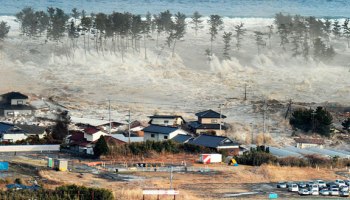iRobot Sends Army Droids Into Japanese Nuclear Plant

Robots originally designed for the US military are surveying the damage at the Fukushima nuclear power plants
A pair of 60-pound military robots originally designed for such tasks as disarming bombs and combat zone surveillance have entered reactor buildings at the stricken Fukushima nuclear power plant in Sendai, Japan.
The PackBot robots, provided by iRobot, are already reporting that the radiation levels in the power plants are too high for humans to spend any significant time in the plants, according to a New York Times report. The robots, outfitted with a set of sensors originally designed for hazardous materials incidents, have entered reactors 1 and 3 of the plant, which were damaged during the catastrophic 11 March earthquake and tsunami.
Warrior robots
Standing by are a pair of much larger Warrior robots, also developed for the US military. These robots are capable of lifting loads of up to 200 pounds and can be used inside the power plant to clear debris and to manipulate controls, open doors and similar tasks. The PackBot robots are outfitted with the sensors, plus high-definition cameras and a folding mast that can extend up to six feet.
According to spokesman Charlie Vaida, iRobot executives were in Singapore for a trade show when the quake happened in Japan. Those executives made the decision to provide the robots to help with the rescue in the nuclear power plants. Engineers worked to outfit their military robots for this mission and then shipped them to Japan.
After the robots were shipped a team of six engineers converged from Singapore, California and Massachusetts to provide training. Meanwhile, iRobot’s distributor in Japan made contact with TEPCO (Tokyo Electric Power Company), the owner of the damaged plants, and arranged for training. Vaida said in an interview with eWEEK that the training took two weeks, and that at that point, the robots were turned over to the TEPCO employees for use in helping with the power plant.
Training
Vaida said TEPCO practiced with the robots for a few days and then on 17 April sent them into the reactor buildings, first into reactor 3 and then reactor 1. The first robots to enter were the PackBots because of their small size and their wealth of sensors. In addition to radiation, the PackBots are able to measure levels of oxygen, ammonia, carbon dioxide and hydrogen. Their cameras are able to show the conditions inside the plants and to survey the damage so that TEPCO engineers will be able to make the best possible decisions on shutting the plants down safely.
While the PackBots and Warriors were originally designed for the US military for use in a variety of conflicts, the company has been marketing them for other uses as well. This is not the first time iRobot has dispatched its machines to survey disaster scenes. The robots were sent first into New York’s collapsed World Trade Centre shortly after the terrorist attacks on 11 September, 2001, and again into the Gulf of Mexico to search for oil after the BP well disaster (iRobot has a robot called the SeaGlider).
iRobot isn’t making money off these efforts. In each case, the company provided its robots, its expertise and its staff at no charge. “It was seeing a situation where we thought we could help,” Vaida said. “It’s a unique technology, and we’re in a unique situation to help out.”
